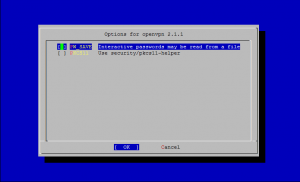FreeBSD Tools: portaudit – FreeBSD’s Third Party Security Audit
Portaudit is a software vulnerability auditing tool for FreeBSD systems. FreeBSD's Portaudit provides a system to check if installed ports are listed in a database of published security vulnerabilities.
The ports-mgmt/portaudit port polls a database for known security issues. This database is updated and maintained by the FreeBSD Security Team and ports developers.
To begin using Portaudit, install it from the Ports Collection:
cd /usr/ports/ports-mgmt/portaudit make install clean
 Print This Post
Print This Post
FreeBSD: How To Install Lighttpd with PHP5-FastCGI and MySQL Support in FreeBSD 8
In this article I'll show you how to install and configure Lighttpd web server on FreeBSD 8.1 with PHP5 support (through FastCGI) and MySQL support.
1. FreeBSD port tree update
Update FreeBSD ports using the following command:
portsnap fetch update
Once is done, we can proceed with the next step.
 Print This Post
Print This Post
FreeBSD: How to Install Adobe Flash in FreeBSD 8
Adobe Flash is a multimedia platform used to add animation, video, and interactivity to Web pages. Flash is frequently used for advertisements and games. More recently, it has been positioned as a tool for "Rich Internet Applications" ("RIAs").
Adobe Flash plugin is not available for FreeBSD. However, a software wrapper for running the Linux version of the plugin exists. This wrapper also supports more plugins such as Adobe Acrobat plugin and RealPlayer.
In FreeBSD 8.X, install the www/nspluginwrapper port. This port requires emulators/linux_base-f10 which is a large port.
cd /usr/ports/www/nspluginwrapper make install clean
The next step is to install the www/linux-f10-flashplugin10 port.
 Print This Post
Print This Post
FreeBSD: Complete Virtualization using VirtualBox
VirtualBox is a virtualization software,originally created by German software company innotek GmbH, purchased by Sun Microsystems, and now developed by Oracle Corporation as part of its family of virtualization products. It is installed on an existing host operating system; within this application, additional guest operating systems, each known as a Guest OS, can be loaded and run, each with its own virtual environment.
In this article I'll show you how to install VirtualBox under FreeBSD.
VirtualBox is available as a FreeBSD port and may be installed using the following commands:
 Print This Post
Print This Post
FreeBSD: How To Create a Network Bridge
A device that connects two networks together into two separate network segments without having to create IP subnets and use a router to connect the segments together is called a "bridge".
To create a bridge use ifconfig command:
ifconfig bridge create
A bridge interface is created and is automatically assigned a randomly generated Ethernet address.
 Print This Post
Print This Post
FreeBSD: System Monitoring with MRTG
The Multi Router Traffic Grapher, or just simply MRTG, is free software for monitoring and measuring the traffic load on network links. It allows the user to see traffic load on a network over time in graphical form.
1. Installing Apache2 HTTP Server
Install Apache on the server you wish to display MRTG stats from:
cd /usr/ports/www/apache22 make install clean
To run Apache2 at system startup, append the following line to /etc/rc.conf :
apache22_enable="YES"
Start Apache2, enter:
/usr/local/etc/rc.d/apache22 start
 Print This Post
Print This Post
How To Install OpenVPN in FreeBSD
OpenVPN is a an open source software application that implements virtual private network (VPN) solutions for creating secure point-to-point or site-to-site connections in routed or bridged configurations and remote access facilities. OpenVPN uses SSL/TLS security for encryption and is capable of traversing network address translators and firewalls.
I. OpenVPN Server - Installation and Configuration
1. Installing OpenVPN Server
To install OpenVPN from FreeBSD ports, enter:
cd /usr/ports/security/openvpn make install clean
 Print This Post
Print This Post
UNIX Tools: fdupes – Get rid of duplicate files
fdupes is a tool for identifying or deleting duplicate files residing within specified directories. It first compares file sizes and MD5 signatures, and then performs a byte-by-byte check for verification.
1. Install fdupes
Type the following commands to install fdupes in FreeBSD:
# cd /usr/ports/sysutils/fdupes
# make install clean
Type the following command to install fdupes in CentOS / Fedora / RHEL (make sure you have rpmforge repo enabled):
 Print This Post
Print This Post
Bandwidth Monitoring Tools for FreeBSD and Linux: iftop
Bandwidth represents the capacity of the connection. The greater the capacity, the more likely that greater performance will follow, though overall performance also depends on other factors, such as latency.
iftop is a free open-source tool to measure bandwidth utilization on the network interfaces on your systems. As the name predicts, iftop is what "top" utility is for CPU usage measurement.
To install iftop in CentOS, Fedora, RHEL ( make sure you have DAG repository enabled ):
# yum install iftop
 Print This Post
Print This Post
UNIX-like Tips and Tricks: find command
The find program is a search utility on Unix-like operating systems. It searches through one or more directory trees of a filesystem, locating files based on some user-specified criteria. By default, find command returns all files below the current working directory. Further, find command allows the user to specify an action to be taken on each matched file. In this article I'll show you some tips for using the find command.
To begin, let's look at the basic structure of the find command:
find start_directory test options criteria_to_match action_to_perform
Example:
In the following command, find will search for any file with the "php" extension in the current directory:
# find . -name "*.php" -print
 Print This Post
Print This Post
